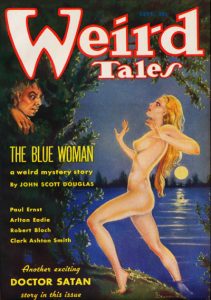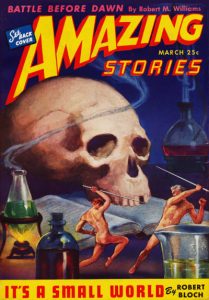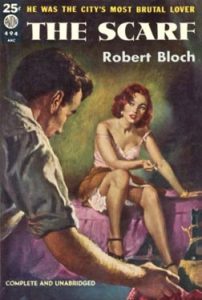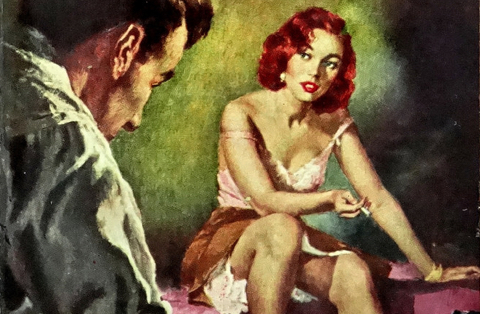 Born one-hundred years ago on April 5, 1917, Robert Bloch is best remembered for his novel PSYCHO, which became the basis for Alfred Hitchcock’s classic film of the same name. The author of more than 200 stories, nearly thirty novels, and a large number of non-fiction articles, screenplays, and teleplays, Bloch got his start as a writing professional in the pulp magazines that are celebrated each summer at PulpFest.
Born one-hundred years ago on April 5, 1917, Robert Bloch is best remembered for his novel PSYCHO, which became the basis for Alfred Hitchcock’s classic film of the same name. The author of more than 200 stories, nearly thirty novels, and a large number of non-fiction articles, screenplays, and teleplays, Bloch got his start as a writing professional in the pulp magazines that are celebrated each summer at PulpFest.
Born in Chicago, Bloch was a precocious child who developed an early interest in vaudeville and theater, as well as storytelling and reading. According to his autobiography, ONCE AROUND THE BLOCH:
Sometime late in the summer of 1927 the family, accompanied by my father’s sister, entered Chicago’s Northwestern Railroad Station to entrain for a suburban destination. Where we were going eludes memory, and it’s not important. What matters is that we passed the huge magazine stand in the terminal.
Here literally hundreds of periodicals — including the then-popular weekly and monthly “pulp” magazines — were ranked in gaudy array. Row after row of garish covers caught the eye; comparatively respectable offerings like ARGOSY, BLUE BOOK, ALL-STORY, and ADVENTURE competed for attention with scores of titles featuring romance, mystery, detective stories, westerns, and every variety of sports. There were even pulps devoted exclusively to railroad yarns, pirates, and WWI air combat. I stared at them, fascinated by this abundance of riches.
It was then that Aunt Lil, with her usual generosity, offered to buy me a magazine to read during the train journey. Scanning titles and covers, I stood poised in delicious indecision. Here was a mustached member of the French Foreign Legion battling a bearded Arab armed with a wicked-looking scimitar . . . beside it, an Indian chief preparing to discharge a flaming arrow at an ambushed wagon train . . . directly overhead, a helpless maiden struggling in the clutches of a gigantic gorilla whose glaring red eyes indicated his zooreastic intentions. Salivating, I surveyed this feast of literature. For a dime I could devour the exploits of a master detective; fifteen cents whould satisfy my appetite for mutiny on the high seas; twenty cents might gorge me with a huge helping of Secret Service operatives foiling the hellish Huns who presumably had substituted a bomb for the torch held by the Statue of Liberty.
 But in the face of these attractions, what more might be offered for an entire quarter?
But in the face of these attractions, what more might be offered for an entire quarter?
That price was imprinted on the cover of a magazine featuring a cloaked, bearded, evil-looking man confronting a recumbent, half-naked girl clad in Oriental garb against a background of Egyptian hieroglyphs. The featured story was “The Bride of Osiris,” by one Otis Adelbert Kline.
Snatching the magazine from the rack, I paged through it quickly, noting such promising titles as “Satan’s Fiddle,” “Creeping Shadows,” “The Phantom Photoplay” and “The Man with a Thousand Legs.”
That did it. “This is the one I want,” I said.
And it was thus that I was introduced to a magazine which changed my life, my very first copy of WEIRD TALES. . . .
What my parents thought of my taste remains unclear to me. Although they seemed uninterested in reading my favorite magazine they offered no objections to cover illustrations of damsels in various stages of distress and undress, and continued to supply me with quarters for monthly issues. . . . to me personally WEIRD TALES became a sort of non-theological BOOK OF REVELATION. What it revealed was that fantastic fiction was not necessarily the work of long-deceased authors like Poe, Hawthorne or de Maupassant; its prose and poetry were not entombed in pages from the past. Death was alive and well and living in Chicago.
By far the most horrifying concept, and to me the most convincing, was an account of ghouls feasting in their burrows below the cemeteries and subways of modern Boston. The story, “Pickman’s Model,” was credited to one H. P. Lovecraft, and I made a mental note to remember both the title and the name of the author. . . . By cutting down on my consumption of carbohydrates, borrowing streetcar passes and confining motion picture attendance to nights when tickets were ten or fifteen cents, I managed to keep the necessary quarter in reserve for the next issue of WEIRD TALES. . . . my addiction to the work of H. P. Lovecraft increased. . . . A Lovecraft junkie, I was hungry for more highs. What could I do?
As it has so frequently during a long lifetime, sheer stupidity came to my rescue. I sat down and . . . scrawled out a letter to Mr. Lovecraft care of the magazine. Identifying myself as an ardent fan (and a brash, presumptuous teenage idiot), I inquired if he might inform me as to where I could locate some of his stories presently out of print.
Thus began a friendship between the young Bloch and “The Old Gentleman.”
 I had become a regular correspondent . . . a member of what was later styled the Lovecraft Circle — a group of friends and fans, many of whom were themselves writers or aspired to be. . . . Quite early in our correspondence HPL suggested I might be interested in trying my own hand at writing with an eye to publication. . . . And since Lovecraft’s suggestion generously included his willingness to inspect my efforts, what more did I need. . . . I trained my sights on the most obvious and visible target, WEIRD TALES. Instead of bombarding them with contributions, I took careful aim before shooting off a story in their direction. . . . Why a battle-scarred veteran of longtime literary warfare would notice the feeble dud I delivered remains a mystery to this very day. But in July, 1934, less than a month after graduating from high school, I received a letter of acceptance for my story. . . . I had suddenly and almost miraculously become a professional writer, a contributor for the very magazine which published the work of my favorite author and present pen pal. . . .
I had become a regular correspondent . . . a member of what was later styled the Lovecraft Circle — a group of friends and fans, many of whom were themselves writers or aspired to be. . . . Quite early in our correspondence HPL suggested I might be interested in trying my own hand at writing with an eye to publication. . . . And since Lovecraft’s suggestion generously included his willingness to inspect my efforts, what more did I need. . . . I trained my sights on the most obvious and visible target, WEIRD TALES. Instead of bombarding them with contributions, I took careful aim before shooting off a story in their direction. . . . Why a battle-scarred veteran of longtime literary warfare would notice the feeble dud I delivered remains a mystery to this very day. But in July, 1934, less than a month after graduating from high school, I received a letter of acceptance for my story. . . . I had suddenly and almost miraculously become a professional writer, a contributor for the very magazine which published the work of my favorite author and present pen pal. . . .
By the end of 1935, Robert Bloch began to sell on a frequent and regular basis to WEIRD TALES. Between that first 1934 sale and the demise of the publication in 1954, he sold nearly seventy stories to “The Unique Magazine.” Having started his career as a mimic of his Lovecraft, his writing gradually took on more psychological overtones and often a sense of humor. He began to branch out in 1939, selling fiction to AMAZING STORIES, STRANGE STORIES, and UNKNOWN. The forties found him contributing to DETECTIVE TALES, DIME MYSTERY MAGAZINE, FANTASTIC ADVENTURES, MAMMOTH DETECTIVE, NEW DETECTIVE, SUPER SCIENCE STORIES, THRILLING MYSTERY, and others. His best-known story of this period, “Yours Truly – Jack the Ripper” — published in the July 1943 WEIRD TALES — led to an assignment writing scripts for a radio program called STAY TUNED FOR TERROR.
It was also during the 1940s that Robert Bloch became a regular attendee of science fiction conventions. In 1948, he was invited to be the professional guest of honor for the World Science Fiction Convention, held in Toronto, the first truly international event of its kind. In 1954, at the San Francisco Worldcon, he met Samuel Peeples, a longtime pulp fan and Hollywood writer. It was this friendship that led to Bloch venturing to Hollywood, where Peeples helped him land an assignment with the television show LOCK-UP. Bloch was soon writing for other series, including ALFRED HITCHCOCK PRESENTS, THRILLER, TRUE, and WHISPERING SMITH. In later years, he would contribute to THE GIRL FROM U.N.C.L.E., I SPY, NIGHT GALLERY, STAR TREK, TALES FROM THE DARKSIDE, and others. Bloch would also write the screenplays for THE CABINET OF CALIGARI, THE NIGHT WALKER, THE SKULL, THE HOUSE THAT DRIPPED BLOOD, and other films. He died on September 23, 1994 in Los Angeles, California.
 PulpFest 2017 will celebrate the 100th anniversary of Robert Bloch’s birth with several special presentations. On Thursday, July 27, author Chet Williamson will read from his novel, Robert Bloch’s PSYCHO: SANITARIUM. Mr. Williamson was the guest of honor at PulpFest 2015. Garyn Roberts — who engaged in an extensive correspondence with Robert Bloch — will discuss the author and his works on Friday, July 28. Professor Roberts — who is working on a Robert Bloch biography — will be sharing rare and landmark material from throughout the author’s life. Garyn was honored with our Munsey Award in 2013.
PulpFest 2017 will celebrate the 100th anniversary of Robert Bloch’s birth with several special presentations. On Thursday, July 27, author Chet Williamson will read from his novel, Robert Bloch’s PSYCHO: SANITARIUM. Mr. Williamson was the guest of honor at PulpFest 2015. Garyn Roberts — who engaged in an extensive correspondence with Robert Bloch — will discuss the author and his works on Friday, July 28. Professor Roberts — who is working on a Robert Bloch biography — will be sharing rare and landmark material from throughout the author’s life. Garyn was honored with our Munsey Award in 2013.
There will be two other Bloch presentations on Friday evening. First, Michael Croteau, creator of Philip José Farmer’s Official Home Page and one of the founders of both FarmerCon and Meteor House, will do a short presentation on Robert Bloch’s relationship with Grand Master of Science Fiction Philip José Farmer. To close the evening, the Narada Radio Company and PULP-POURRI THEATRE will present a mock radio drama of Bloch’s “Return to the Sabbath,” originally published in the July 1938 WEIRD TALES. PULP-POURRI THEATRE is an all-new audio drama anthology series that has its origins in vintage pulp fiction, but presents its stories in the modern way. Pete Lutz is the company’s producer-director. You can sample their work online or via iTunes.
The convention will take place from Thursday evening, July 27, through Sunday afternoon, July 30, at the DoubleTree by Hilton Hotel Pittsburgh – Cranberry, just nineteen miles north of the exciting city of Pittsburgh. You can book your room directly through the PulpFest website. Just click the “Book a Room for 2017” link on our home page or call 1-800-222-8733. Be sure to mention PulpFest in order to receive the convention rate.
Start making your plans now to celebrate the 100th anniversary of the birth of PSYCHO author Robert Bloch at the “pop culture center of the universe” called PulpFest 2017.
(Released in 1960, Alfred Hitchcock’s PSYCHO is considered to be a masterpiece of suspense. This classic film was based on Robert Bloch’s novel of the same name, originally published in 1959 by Simon and Schuster. Hitchcock’s film was nominated for four academy awards and helped its author to achieve fame and fortune, largely through his work in television and motion pictures.
Robert Bloch — who got his start as a writing professional working for the pulps — first discovered the rough-paper magazines through the August 1927 issue of WEIRD TALES, featuring front cover art by Hugh Rankin. A newspaper illustrator, Rankin began working for WEIRD TALES in 1927, doing the vast majority of the magazine’s interior illustrations during the late twenties and all of its covers, beginning with the July 1927 number. He continued as the pulp’s sole cover artist through the February 1931 issue. Afterward, he began sharing the cover with such artists as C. C. Senf, J. Allen St. John, and Margaret Brundage. Rankin continued to paint covers for WEIRD TALES into 1936.
Bloch’s fourth published story — “The Shambler from the Stars” — was not only dedicated to his writing mentor, H. P. Lovecraft, but also featured “The Old Gentleman” as an important character. Published in the September 1935 issue of WEIRD TALES and featuring cover art by Margaret Brundage, the story concerns a would-be writer who obtains a copy of an occult volume known as DE VERMIS MYSTERIIS. He takes the forbidden volume to a Providence-based mystic who, in his excitement, calls down an invisible, vampiric monster. Bloch’s tale would lead Lovecraft to write “The Haunter of the Dark,” published in the December 1936 WEIRD TALES. It was dedicated to Robert Bloch and featured a character named “Robert Blake.”
 Following a write-up in the Milwaukee papers in 1935, the new author was invited to join The Milwaukee Fictioneers. A professional writers’ group, its membership also included pulp writers Fredric Brown, Ralph Milne Farley, Lawrence Keating, Ray Palmer, and Stanley G. Weinbaum. Soon after assuming the editorship of AMAZING STORIES in 1938, Palmer would publish Robert Bloch’s first science fiction story,“Secret of the Observatory.” Bloch would author a substantial number of stories for Palmer’s AMAZING STORIES, FANTASTIC ADVENTURES, and OTHER WORLDS SCIENCE STORIES, including “It’s a Small World,” the cover story for the March 1944 AMAZING, featuring artwork by J. Allen St. John.
Following a write-up in the Milwaukee papers in 1935, the new author was invited to join The Milwaukee Fictioneers. A professional writers’ group, its membership also included pulp writers Fredric Brown, Ralph Milne Farley, Lawrence Keating, Ray Palmer, and Stanley G. Weinbaum. Soon after assuming the editorship of AMAZING STORIES in 1938, Palmer would publish Robert Bloch’s first science fiction story,“Secret of the Observatory.” Bloch would author a substantial number of stories for Palmer’s AMAZING STORIES, FANTASTIC ADVENTURES, and OTHER WORLDS SCIENCE STORIES, including “It’s a Small World,” the cover story for the March 1944 AMAZING, featuring artwork by J. Allen St. John.
Although PSYCHO is certainly Robert Bloch’s most famous novel, his first book-length work, THE SCARF — originally published in 1947 by Dial Press — is considered by many critics to be his best work. According to Cullen Gallagher, “It tells the story of a writer . . . who uses real women as models for his characters. But as soon as he is done writing the story, he is compelled to murder them, and always the same way: with the maroon scarf he has had since childhood.” One of the finest editions of THE SCARF is Avon’s 1952 paperback reprint of the work, featuring a beautiful cover by Charles Binger.)







